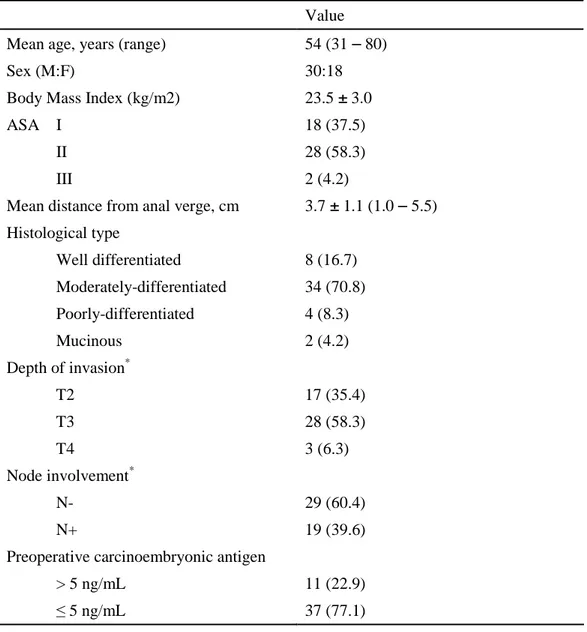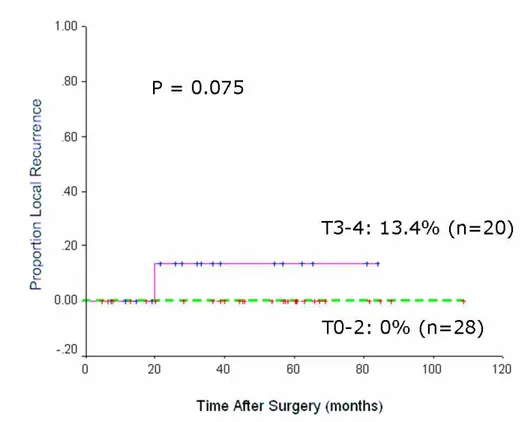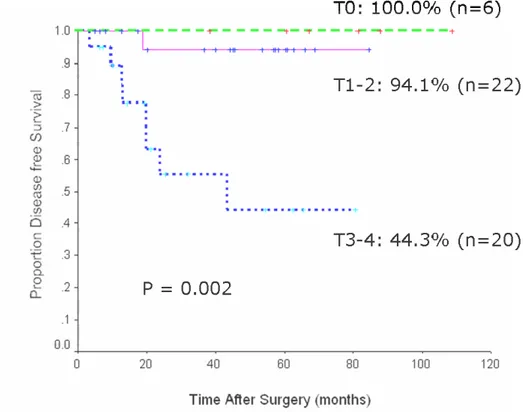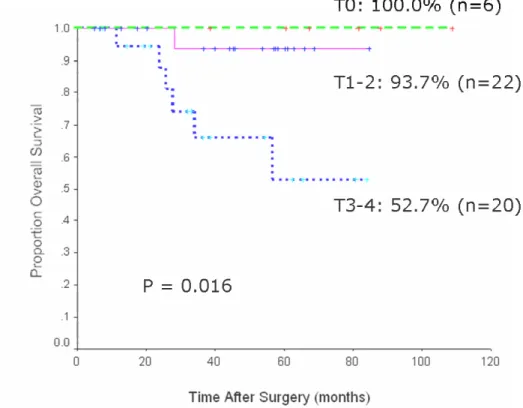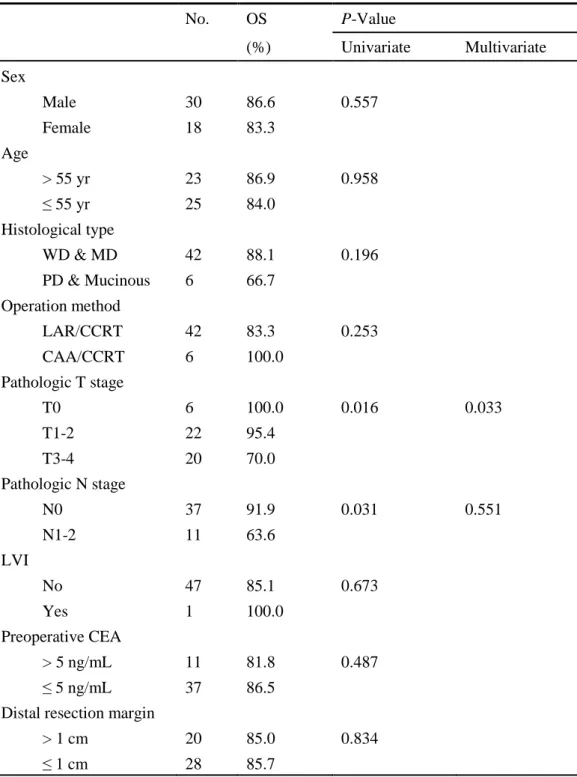Oncologic Results of Preoperative
Chemoradiation in Low Rectal Cancer
Jung Wook Huh
Department of Medicine
Oncologic Results of Preoperative
Chemoradiation in Low Rectal Cancer
Directed by Professor Seung-Kook Sohn
The Master's Thesis submitted to the Department of
Medicine, the Graduate School of Yonsei University in
partial fulfillment of the requirements for the degree of
Master of Medical Science
Jung Wook Huh
This certifies that the Master's Thesis
of Jung Wook Huh is approved.
---
[Thesis Supervisor: Seung-Kook Sohn]
---
[Kwan-Chul Tark: Thesis Committee Member#1]
---
[Nam Kyu Kim: Thesis Committee Member#2]
The Graduate School
Yonsei University
ACKNOWLEDGEMENTS
석사 과정을 마칠 수 있도록 모든 것을 준비하여 주시고, 인도하여 주시고, 지혜를 주신 하나님께 제일 먼저 감사드립니다. 본 논문을 준비하고 진행하는 과정 뿐 아니라 대장 항문 전문의로서 이 자리에 있기까지 부족한 저에게 아낌없는 가르침과 격려로 이끌어 주신 손승국 지도교수님께 감사의 말씀을 올립니다. 또한 논문이 완성되기까지 세심히 심사해 주시고 아낌없는 충고로 부족한 부분을 메워주신 탁관철 교수님과 김남규 교수님께 감사드립니다. 특히 이러한 기초를 훌륭히 만들어 주신 박윤아 선생님께도 감사의 말을 전합니다. 이 자리에 오기까지 사랑과 격려로 키워주신 부모님과 따뜻한 관심과 배려를 해주시는 장인어른, 장모님께 감사드립니다. 일에 지쳐 힘들 때마다 언제나 힘이 되어주는 사랑하는 아내 박지현과 아들 재준이와 이 작은 기쁨을 함께 나누고 싶습니다. 저자 씀TABLE OF CONTENTS
ABSTRACT ··· 1
I. INTRODUCTION ··· 3
II. PATIENTS AND METHODS ··· 5
III. RESULTS ··· 10
1. Summary of patients and extents of tumor ··· 10
2. Postoperative complications ··· 12
3. Recurrence rate and survival rate ··· 13
4. Prognostic factors affecting survival ··· 16
IV. DISCUSSION ··· 18
V. CONCLUSION ··· 22
REFERENCES ··· 23
LIST OF FIGURES
Figure 1. Five-year local recurrence rates ··· 14
Figure 2. Five-year disease free survival rates ··· 15
Figure 3. Five-year overall survival rates ··· 16
LIST OF TABLES
Table 1. Patients and tumor characteristics ··· 11
Table 2. Postoperative complications ··· 12
Table 3. Patterns of recurrence ··· 13
Table 4. Analysis for predicting favorable survival ·· 17
ABSTRACT
Oncologic Results of Preoperative Chemoradiation in Low Rectal Cancer
Jung Wook Huh
Department of Medicine
The Graduate School, Yonsei University
(Directed by Professor Seung-Kook Sohn)
Sphincter-saving operations for low rectal cancer are on the rise. Here, we investigated the oncologic outcomes of patients who underwent sphincter-saving operations following preoperative chemoradiation for low rectal cancer.
This study included 48 patients who underwent sphincter-saving operations after preoperative chemoradiation with curative intent for locally advanced rectal cancer that was located at less than 5.5 cm from the anal verge. All patients, initially considered for abdominoperineal resection (APR) underwent concurrent chemoradiation therapy (CCRT) consisting of preoperative 5-fluorouracil-based chemotherapy and pelvic radiation (4,500-5,040 cGy) and then followed by surgery 6
weeks after. The oncologic outcomes were investigated, and factors affecting survival were evaluated.
The median follow-up period was 42.1±25.5 (range 5 - 109) months. The mean distance from the anal verge to the lesion was 3.7±1.1 (range 1.0 - 5.5) cm. The overall postoperative complication rate was 32.6%. The recurrence developed in 9 patients (18.8%). The 5-year local recurrence rate was 0% in patients of pathologic (p) primary tumor (T) pT0-2 group and 13.4% in patients of pT3-4 group (p = 0.075). The 5-year survival rate was 100% for patients of pT0 group, 93.7% for patients of pT1-2 group, and 52.7% for patients of pT3-4 group (p = 0.016). In a multivariate analysis, the pathologic primary tumor stage was a statistically significant independent factor related to the disease-free survival (p = 0.014) and overall survival (p = 0.033).
In conclusions, sphincter-saving operation after preoperative chemoradiation is a mandatory option without deterioration of oncologic outcomes for the treatment of locally advanced low rectal cancer patients for whom initially APR are considered. Meanwhile pathologic primary tumor stage can be considered as a valuable clinical indicator in predicting prognosis of low rectal cancer.
……….………..
Key words: Low rectal cancer, Preoperative chemoradiation, Sphincter-saving operation
Oncologic Results of Preoperative Chemoradiation in Low Rectal Cancer
Jung Wook Huh
Department of Medicine
The Graduate School, Yonsei University
(Directed by Professor Seung-Kook Sohn)
I. INTRODUCTION
Abdominoperineal resection (APR) has been known as a standard treatment modality
for lower rectal adenocarcinoma. Recent reports indicate, however, this procedure is
associated with worse prognosis comparing to anterior resection (AR).1,2 The number
of sphincter-saving operation for lower rectal cancer is increasing related to improved
(CCRT), and realization of the fact 1 cm of distal resection margin is sufficient
enough to achieve cure.3-6 A recent prospective randomized trial demonstrated that
preoperative chemoradiotherapy improves sphincter preservation. Specifically in
those patients who were clinically determined to require APR for rectal cancer,
sphincter preservation was significantly increased in the preoperative (39%) versus
postoperative chemoradiotherapy group (20%).7
The aim of this study was to investigate the oncologic outcomes of patients who
underwent sphincter-saving operations following preoperative chemoradiation for
lower rectal cancer that has been treated by APR traditionally. Also factors affecting
II. PATIENTS AND METHODS
Between December 1995 and August 2004, 48 consecutive patients, who were treated
at the Yongdong Severance Hospital and the Yonsei Medical Center, underwent
sphincter-saving operation with curative intent for locally advanced (endorectal
ultrasound T3/T4 or N1 and/or clinically bulky) low rectal cancer located at less than
5.5 cm from the anal verge. All patients in this study had histologically confirmed as
primary adenocarcinoma of the rectum. Patients who were requiring local therapy for
rectal cancer or patients with distant metastases were excluded in this study.
Sphincter-saving operation was classified into an ultralow anterior
resection/colorectal anastomosis with staplers (CRA) group and an ultralow anterior
resection/handsewn coloanal anastomosis (CAA) group.
Diagnostic evaluations included physical examination, rigid proctoscopy,
colonoscopy or double-contrast barium enema, endorectal ultrasound (ERUS) with
abdominopelvic computed tomography (CT), abdominopelvic magnetic resonance
of serum carcinoembryonic antigen level. The location of the tumor was defined as
the distance from the anal verge to the caudal margin of the tumor which was
measured by digital examination and rigid proctoscopy. Staging ERUS studies were
performed whenever technically feasible. For those patients with an obstructing tumor
that prevents passage of ultrasound probe for proper study of the entire lesion,
abdominopelvic CT or pelvic MRI were performed to assess the extent of local tumor
invasion.
All 48 patients received preoperative concurrent chemoradiation therapy. The
whole pelvic field received 25 fractions of 180 cGy/day over five weeks for total of
4,500 - 5,040 cGy. The four-field box technique was used. The upper border of the
tumor bed field was the L5/S1 junction and the lower limit was the inferior border of
the ischial tuberosity. The lateral borders were 1.5 cm lateral to the bony pelvis, and
the posterior border encompassed the entire sacrum. The anal canal was included in
all patients. Chemotherapy with oral fluorouracil (FU) was given to all patients who
received radiotherapy. Oral doxifluridine (900 mg/m2, Furtulon, Roche, Seoul,
seven days before the operation. Surgery was performed six to eight weeks following
completion of radiation therapy. When feasible, patients underwent CRA using the
double-stapled technique and a circular stapling device (Autosuture, US Surgical,
Norwalk, CT). However, a handsewn CAA was performed for tumors that could not
be anastomosed with staplers due to limited distal margins or a narrow pelvis. A
diverting stoma and a colonic reservoir with pouch were excluded in those who
underwent CRA or CAA.
Standard pathologic analysis was performed on all radical rectal resection
specimens. After the final histopathologic examination, the rectal tumor was staged
according to the 6th UICC TNM staging system. Resection specimens were evaluated
for depth of tumor penetration, lymph node involvement, differentiation,
lymphovascular invasion, and distal resection margins. Patients with either lymph
node involvement or tumors that invaded the muscularis propria received
postoperative 5-fluorouracil-based chemotherapy, consisting of 425 mg/m2 of
5-fluorouracil plus 30 mg leucovorin for 5 days every 28 days for 12 cycles. Patients
months for the next 3 years, and annually thereafter. If the patient did not return for
observation after one year, the information was obtained by a letter or telephone.
On a semiannual basis or when there was a suspicion of recurrence, follow-up
examinations included clinical history, physical examination, serum
carcinoembryonic antigen levels, chest x-ray, abdomino-pelvic computed tomography,
colonoscopy, and positron emission tomography (PET) scanning was used if available.
Determination of recurrence was made by clinical and radiologic examinations or by
histological confirmation. Recurred patients were divided into three groups: local,
systemic, and combined. Local recurrence was defined as recurrence within the
pelvis; systemic recurrence was defined as disease outside of the pelvis. The main
patterns of recurrence were recorded as the first site of detectable failure during the
follow-up period.
Statistical evaluation was carried out using the statistics program SPSS 12.0®
(SPSS, Chicago, IL, USA). The Kaplan-Meier methodology was used to estimate
overall survival, disease-free survival, and local recurrence rates; the log-rank test
generated by a forward stepwise selection of variables, and a P value of 0.1 was
adopted as the limit for inclusion of a covariant. A value of p < 0.05 was considered
III. RESULTS
1. Summary of patients and extents of tumor
Male patients were predominant as of 62.5% (30/48). The mean distance from the
anal verge to the caudal border of lesion was 3.7±1.1 (range 1.0 - 5.5) cm. In clinical
assessment based on ERUS using abdomino-pelvic CT scan and/or MRI, patients
with T2 was 17 (35.4%), T3 was 28 (58.3%), and T4 was 3 (6.3%), respectively. In
40% of patients (19/48), lymph node involvement was suspected. In 11 patients
(22.9%), pre-treatment serum carcinoembryonic antigen level was above 5 ng/mL.
Patient and tumor characteristics before treatment for all 48 patients are summarized
Table 1. Patients and tumor characteristics before treatment Value
Mean age, years (range) 54 (31 – 80)
Sex (M:F) 30:18
Body Mass Index (kg/m2) 23.5 ± 3.0
ASA I 18 (37.5)
II 28 (58.3)
III 2 (4.2)
Mean distance from anal verge, cm 3.7 ± 1.1 (1.0 – 5.5) Histological type Well differentiated 8 (16.7) Moderately-differentiated 34 (70.8) Poorly-differentiated 4 (8.3) Mucinous 2 (4.2) Depth of invasion* T2 17 (35.4) T3 28 (58.3) T4 3 (6.3) Node involvement* N- 29 (60.4) N+ 19 (39.6)
Preoperative carcinoembryonic antigen
> 5 ng/mL 11 (22.9) ≤ 5 ng/mL 37 (77.1) ASA = American Society of Anesthesiologists.
*
Determined by endorectal ultrasound or abdominopelvic magnetic resonance imaging according to 6th AJCC staging system.
2. Postoperative complications
The overall postoperative complication rate was 32.6% (14/48). The most common
complication was small bowel obstruction (9.3%, 4 patients), and followed by anal
stenosis (7.0%, 3 patients), urinary retention, wound infection and so forth. There was
no postoperative mortality within 30 days of operation.
Table 2. Postoperative complications
Value Small bowel obstruction 4 (9.3)
Urinary retention 2 (4.7) Wound infection 2 (4.7) Anal stenosis 3 (7.0) Pneumonia 1 (2.3) Atelectasis 1 (2.3) Anastomotic leakage 1 (2.3) Overall morbidity 14 (32.6)
3. Recurrence rate and survival rate
The median follow-up period was 42.1±25.5 (range 5 - 109) months. The overall
recurrence rate was 18.8% (9/48) as local of 4.2%, systemic of 12.5% and combined
recurrence of 2.1%, respectively (Table 3). The 5-year local recurrence rate was 0%
in patients of pathologic (p) primary tumor (T) pT0-2 group and 13.4% in patients of
pT3-4 group (p = 0.075)(Fig. 1).
Table 3. Patterns of recurrence
Value
Local recurrence 2 (4.2%)
Systemic recurrence 6 (12.5%) Combined recurrence 1 (2.1%)
Fig. 1 Five-year local recurrence rates in T0-2 group and T3-4 group after combined sphincter saving operation and preoperative chemoradiation.
Survival rate was analyzed according to pathologic depth of rectal wall invasion (Fig.
2 and 3). There was significant difference in year disease free survival rate and
Fig. 2 Five-year disease free survival rates after combined sphincter saving operation and preoperative chemoradiation.
Fig. 3 Five-year overall survival rates after combined sphincter saving operation and preoperative chemoradiation.
4. Prognostic factors affecting survival
Univariate analyses of factors affecting survival showed pathologic primary tumor
and pathologic lymph node stages to be significant factors. Multivariate analysis of
these factors revealed that pathologic primary tumor stage was one of the most
Table 4. Analysis for predicting favorable 5-year overall survival (OS) No. OS P-Value (%) Univariate Multivariate Sex Male 30 86.6 0.557 Female 18 83.3 Age > 55 yr 23 86.9 0.958 ≤ 55 yr 25 84.0 Histological type WD & MD 42 88.1 0.196 PD & Mucinous 6 66.7 Operation method LAR/CCRT 42 83.3 0.253 CAA/CCRT 6 100.0 Pathologic T stage T0 6 100.0 0.016 0.033 T1-2 22 95.4 T3-4 20 70.0 Pathologic N stage N0 37 91.9 0.031 0.551 N1-2 11 63.6 LVI No 47 85.1 0.673 Yes 1 100.0 Preoperative CEA > 5 ng/mL 11 81.8 0.487 ≤ 5 ng/mL 37 86.5
Distal resection margin
> 1 cm 20 85.0 0.834 ≤ 1 cm 28 85.7
IV. DISCUSSION
APR with a permanent colostomy has been the classical operation for cancer in the
distal third of the rectum. The rate of performing APR, however, has been falling and
was recently quoted at 10% for all rectal cancers.8 The absolute indication in APR for
a patient with rectal cancer has changed with improvements in surgical techniques,
employment of preoperative chemoradiation, and enhanced understanding of distal
tumor spread.3-6 Fucini et al.9 reported that selected patients with very low-lying rectal
cancers infiltrating the levator muscles and responding to preoperative
chemoradiation therapy could still be treated with an advanced sphincter-sparing
procedure, instead of an abdominoperineal excision. Furthermore, oncologic and
functional results in those patients seemed to be satisfactory. Although some authors
have questioned the advantages of sphincter saving operation for lower rectal cancer
in terms of quality of life,10 permanent stoma must be considered a serious handicap.
Engel et al.11 reported that patients undergoing an low anterior resection had a
functioning at 4 years, as compared with those who had treated by APR. In our study,
postoperative morbidity rates such as small bowel obstruction and urinary retention
was 32.6%, however there was no postoperative morbidity.
This practice of sphincter preservation is acceptable only if the long-term oncologic
outcomes are not worse than for APR. Rullier et al.12 reported a series of 43 advanced
low recal cancers (40 T3 and 3 T4), 70% of which were within 2 cm of the anal
sphincter. All patients underwent sphincter-saving operations after preoperative
chemoradiation. The authors concluded that the preoperative chemoradiation and
downstaging allowed sphincter preservation. Our current study is in agreement that
preoperative chemoradiation for the purpose of sphincter preservation may be the
preferred approach in selected patients. It has not been settled whether oncologic
outcomes for sphincter-saving operation are better than those of APR.1,13-16 Wibe et
al.13 showed that survival was significantly worse in patients who underwent APR
compared with those who received AR (55% vs. 68%; p < 0.001). Another study by
Law and Chu14 also reported significantly worse local control and survival for
cancer-specific survival. In contradistinction to these studies, Chuwa and
Seow-Choen15 noted that a well-conducted total mesorectal excision (TME) in the setting of
an APR did not result in worse oncologic outcomes than those of AR; moreover, the
type of operation did not affect the oncologic outcomes if consistent standardized
surgical techniques were performed in a specialty unit. In general, the evidence
appears to suggest that local recurrence is a reflection of the initial tumor biology
(stage, histologic grade, and lymphovascular invasion) rather than the type of
procedure initially performed.17,18 In our study, the depth of rectal wall invasion was
statistically significant factor affecting recurrence and survival. Our results showed
that the 5-year survival rate of patients with complete response (pT0) was 100%,
pT1-2 was 93.7%, and pT3-4 was 5pT1-2.7% (p = 0.016). Multivariate analysis revealed that
the pathologic T stage was the independent prognostic factor. Thus, we propose that
depth of rectal wall invasion status in the postirradiated tumor specimen was the
strongest factor affecting prediction of long-term oncologic outcomes.
Sphincter preservation is the primary goal of preoperative irradiation for locally
manifested by downsizing and downstaging of the tumor.19-21 Prospective randomized
trials by the German Rectal Cancer Study Group identified that preoperative
chemoradiotherapy, as compared with standard postoperative chemoradiotherapy,
improved local control but did not improve overall survival.7 Furthermore, this
neoadjuvant therapy combined with advanced surgical techniques facilitates pelvic
dissection and affords direct visual control for the transection of the distal resection
margin.12 Guillem et al.22 analysed 297 patients with locally advanced rectal cancer
treated with preoperative chemoradiation followed by total mesorectal excision. The
authors documented that a pathologic response greater than 95%, absence of
lymphovascular invasion and/or perineural invasion, and negative lymph nodes in the
post-CCRT pathologic speciemen are independently predictive of improved
long-term overall and recurrence-free survival. In the present multivariate analysis,
pathologic T stage was the only independent factor affecting overall survival (p =
0.033). Our current data suggest that the pathologic T stage can provide valuable
prognostic information about survival in patients undergoing curative resection for
V. CONCLUSION
We suggest that sphincter-saving operation after preoperative chemoradiation is a
mandatory option without deterioration of oncologic outcomes for the treatment of
locally advanced low rectal cancer patients for whom initially APR are considered.
Meanwhile pathologic primary tumor stage can be considered as a valuable clinical
REFERENCES
1. Nagtegaal ID, van de Velde CJ, Marijnen CA, van Krieken JH, Quirke P. Low
rectal cancer: a call for a change of approach in abdominoperineal resection. J
Clin Oncol 2005;23:9257-64.
2. Marr R, Birbeck K, Garvican J, Macklin CP, Tiffin NJ, Parsons WJ, et al. The
modern abdominoperineal excision: the next challenge after total mesorectal
excision. Ann Surg 2005;242:74-82.
3. Andreola S, Leo E, Belli F, Bonfanti G, Sirizzotti G, Greco P, et al.
Adenocarcinoma of the lower third of the rectum surgically treated with a
<10-MM distal clearance: preliminary results in 35 N0 patients. Ann Surg Oncol
2001;8:611-5.
4. Rouanet P, Fabre JM, Dubois JB, Dravet F, Saint Aubert B, Pradel J, et al.
Conservative surgery for low rectal carcinoma after high-dose radiation.
Functional and oncologic results. Ann Surg 1995;221:67-73.
preoperative radiation therapy and coloanal anastomosis. Int J Radiat Oncol
Biol Phys 1995;31:553-9.
6. Janjan NA, Khoo VS, Abbruzzese J, Pazdur R, Dubrow R, Cleary KR, et al.
Tumor downstaging and sphincter preservation with preoperative
chemoradiation in locally advanced rectal cancer: the M. D. Anderson Cancer
Center experience. Int J Radiat Oncol Biol Phys 1999;44:1027-38.
7. Sauer R, Becker H, Hohenberger W, Rodel C, Wittekind C, Fietkau R, et al.
Preoperative versus postoperative chemoradiotherapy for rectal cancer. N Engl
J Med 2004;351:1731-40.
8. Dowdall JF, Maguire D, McAnena OJ. Experience of surgery for rectal cancer
with total mesorectal excision in a general surgical practice. Br J Surg
2002;89:1014-9.
9. Fucini C, Elbetti C, Petrolo A, Casella D. Excision of the levator muscles with
external sphincter preservation in the treatment of selected low T4 rectal
cancers. Dis Colon Rectum 2002;45:1697-705.
Sphincter-sparing surgery after preoperative radiotherapy for low rectal
cancers: feasibility, oncologic results and quality of life outcomes. Br J Cancer
2000;82:1131-7.
11. Engel J, Kerr J, Schlesinger-Raab A, Eckel R, Sauer H, Holzel D. Quality of
life in rectal cancer patients: a four-year prospective study. Ann Surg
2003;238:203-13.
12. Rullier E, Goffre B, Bonnel C, Zerbib F, Caudry M, Saric J. Preoperative
radiochemotherapy and sphincter-saving resection for T3 carcinomas of the
lower third of the rectum. Ann Surg 2001;234:633-40.
13. Wibe A, Syse A, Andersen E, Tretli S, Myrvold HE, Soreide O. Oncological
outcomes after total mesorectal excision for cure for cancer of the lower
rectum: anterior vs. abdominoperineal resection. Dis Colon Rectum
2004;47:48-58.
14. Law WL, Chu KW. Abdominoperineal resection is associated with poor
oncological outcome. Br J Surg 2004;91:1493-9.
worse than those of anterior resections. Dis Colon Rectum 2006;49:41-9.
16. Dehni N, McFadden N, McNamara DA, Guiguet M, Tiret E, Parc R. Oncologic
results following abdominoperineal resection for adenocarcinoma of the low
rectum. Dis Colon Rectum 2003;46:867-74.
17. Rubbini M, Vettorello GF, Guerrera C, Mari C, De Anna D, Mascoli F, et al. A
prospective study of local recurrence after resection and low stapled
anastomosis in 183 patients with rectal cancer. Dis Colon Rectum
1990;33:117-21.
18. Law WL, Chu KW. Local recurrence following total mesorectal excision with
double-stapling anastomosis for rectal cancers: analysis of risk factors. World J
Surg 2002;26:1272-6.
19. Gerard A, Buyse M, Nordlinger B, Loygue J, Pene F, Kempf P, et al.
Preoperative radiotherapy as adjuvant treatment in rectal cancer. Final results
of a randomized study of the European Organization for Research and
Treatment of Cancer (EORTC). Ann Surg 1988;208:606-14.
Preoperative chemoradiotherapy and radical surgery for locally advanced distal
rectal adenocarcinoma: pathologic findings and clinical implications. Dis
Colon Rectum 2001;44:1123-8.
21. Valentini V, Coco C, Cellini N, Picciocchi A, Fares MC, Rosetto ME, et al.
Ten years of preoperative chemoradiation for extraperitoneal T3 rectal cancer:
acute toxicity, tumor response, and sphincter preservation in three consecutive
studies. Int J Radiat Oncol Biol Phys 2001;51:371-83.
22. Guillem JG, Chessin DB, Cohen AM, Shia J, Mazumdar M, Enker W, et al.
Long-term oncologic outcome following preoperative combined modality
therapy and total mesorectal excision of locally advanced rectal cancer. Ann
ABSTRACT (IN KOREAN)
하부 직장암에서 수술 전 화학방사선 요법의 치료 효과
<지도교수 손승국>
연세대학교 대학원 의학과
허 정 욱
최근 하부 직장암에 대한 괄약근 보존술의 빈도가 크게 증가하고 있다. 본 연구의 목적은 국소 진행성 하부 직장암에서 수술 전 화학방사선 요법으로 병기 하강을 유도하여 괄약근 보존술을 시행 받은 환자들의 종양학적인 결과를 알아보고자 하였다. 본 연구는 직장연에서 5.5 cm 미만에 위치한 국소 진행성 직장암 환자 48 명을 대상으로 하였다. 전체 환자는 괄약근 보존을 목적으로 수술 전 5-fluorouracil 을 기본으로 한 항암치료 및 방사선 치료(4,500-5,040 cGy)를 받았으며, 6 주 후에 근치적인 괄약근 보존술을 시행받았다. 종양학적인 결과 및 생존에 영향을 미치는 요인들에 대해서 조사하였다. 중앙 추적기간은 42.1±25.5 (5-109) 개월이었다. 항문연에서 종양까지의 평균 거리는 3.7±1.1 (1.0-5.5) cm 였다. 수술 후 합병증은총 14 예(32.6%)가 발생하였으며, 총 9 예(18.8%)의 수술 후 재발이 발생했다. 5 년 국소 재발률을 병리학적 T 병기에 따라 구분해보면 T0-2 에서는 0%, T3-4 에서는 13.4%였다 (p = 0.075). 5 년 전체 생존율은 T0 에서 100%, T1-2 에서 93.7%, T3-4 에서 52.7%였다 (p = 0.016). 다변량 분석 시 병리학적 T 병기만이 무병 생존율 (p = 0.014)과 전체 생존율 (p = 0.033) 양측 모두에 영향을 미치는 예측 인자로 판명되었다. 결론적으로 기존 복회음절제술을 시행해야만 했던 국소 진행성 하부 직장암이라도 수술 전 화학방사선 요법으로 병기하강을 유도하고 이후 괄약근 보존술을 시행하는 방법으로 치료함으로써 항문의 기능을 유지하면서도 안전하고 우수한 치료 성적을 얻을 수 있었다. 또한 방사선 조사 후의 병리학적 T 병기는 생존율에 영향을 미치는 가장 직접적인 예측인자임을 확인할 수 있었다. ……… 핵심되는 말: 하부 직장암, 수술 전 화학방사선 요법, 괄약근 보존술
